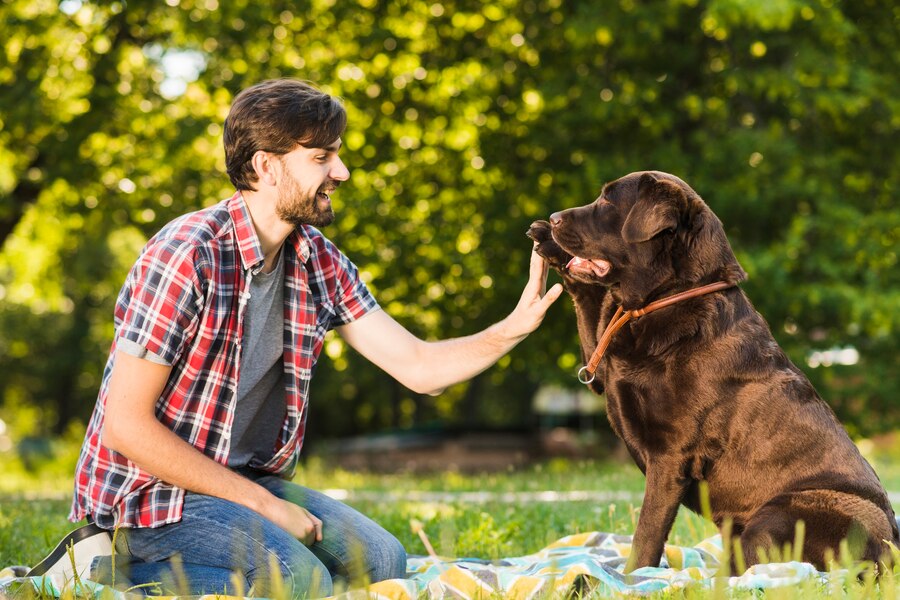If you’ve ever been sitting with your dog and suddenly felt little nibbles or gentle bites, you’re not alone. Many dog owners are familiar with this behavior, but it can still leave them wondering: why does my dog nibble on me? While this behavior may seem odd or even a bit concerning at times, there are several reasons why dogs engage in nibbling or light biting. Understanding these motivations can help you respond appropriately, ensuring your dog’s actions remain harmless and positive.
1. Affectionate Behavior
One of the most common reasons dogs nibble on their owners is simply to show affection. Dogs have various ways of expressing love, and nibbling can be one of them. This is especially true for puppies, who use their mouths to explore the world and interact with their mothers and littermates. As they grow older, they continue to use their mouths to express affection, and nibbling on their owners can become a comforting, loving gesture.
For many dogs, nibbling or gently gnawing on their owner’s hands, arms, or legs is a way to seek closeness. This behavior is often seen as a sign of trust, as the dog feels secure enough to engage in physical contact. If your dog nibbles on you while you’re petting them, they may be returning the affection, wanting to bond further.
2. Teething (in Puppies)
Puppies, in particular, are notorious for nibbling on anything they can find, including their owners. Just like human babies, puppies go through a teething phase that typically occurs between the ages of 3 to 6 months. During this time, their baby teeth are falling out, and adult teeth are coming in. Teething can be uncomfortable for puppies, and chewing or nibbling is a way for them to alleviate some of that discomfort.
If your dog is a young pup, their nibbling might be more frequent and persistent. It’s their way of finding relief from the pressure of new teeth coming in. They may target your fingers or hands because they are often readily available to them, especially if you’re interacting with them closely.
3. Exploration and Play
Dogs, especially puppies and young dogs, often nibble on things as part of their exploratory behavior. Since dogs rely heavily on their mouths to interact with their environment, they may nibble on you simply because they’re curious or excited. This behavior is akin to how puppies will nibble on other dogs during playtime. In these instances, the nibbling is part of their playful interaction and is not meant to cause harm.
If your dog’s nibbling happens during play, it’s likely a harmless and natural behavior. Dogs often nibble on their toys, other animals, and people as part of their play routine. They’re testing boundaries, enjoying interaction, and seeking attention.
4. Attention-Seeking Behavior
Dogs are incredibly intelligent and quick to learn how to get their owner’s attention. If you’ve ever noticed that your dog nibbles on you when they want something—whether it’s petting, food, or just to play—it’s likely that the nibbling is a form of communication. Your dog has learned that nibbling on you can prompt a response, and they may repeat the behavior to get your attention.
This type of nibbling is especially common when dogs are bored or anxious and need some stimulation. If your dog isn’t getting enough physical exercise, mental enrichment, or attention from you, they may nibble as a way of getting you to engage with them. In such cases, it’s important to assess whether your dog’s needs are being met and if additional mental or physical stimulation is required.
5. Comforting or Stress Relief
Nibbling can also be a self-soothing behavior for some dogs. Just as humans may chew on their nails or tap their feet when they’re stressed, dogs may nibble as a coping mechanism when they feel anxious or uneasy. This could happen in response to stress, fear, or separation anxiety. If your dog is feeling insecure, they might nibble on you or your clothing to comfort themselves.
If the nibbling occurs more often during times of stress or when your dog is left alone, it might be worth investigating the underlying cause. Ensuring your dog feels safe and secure in their environment can help reduce the frequency of this behavior.
6. Boredom or Lack of Stimulation
If your dog isn’t getting enough physical or mental exercise, they may turn to nibbling as a way to entertain themselves. Dogs, especially active breeds, require regular physical activity, mental challenges, and stimulation to stay happy and healthy. If they don’t receive enough of these things, they might resort to behaviors like nibbling on their owner’s skin or clothing as a form of self-entertainment.
7. Possible Medical Concerns
Although nibbling is generally a normal and harmless behavior, in rare cases, it could indicate an underlying medical issue. If your dog’s nibbling is accompanied by other unusual behaviors, signs of distress, or pain, it’s a good idea to consult with a veterinarian. Conditions like dental problems, skin allergies, or even neurological issues could cause discomfort that leads to excessive nibbling or chewing.
Conclusion
While it can feel puzzling when your dog nibbles on you, it’s typically a natural, benign behavior that stems from affection, play, teething, or a desire for attention. Understanding why your dog engages in this behavior can help you respond in a way that fosters positive interactions. Whether they’re expressing love, playing, or seeking comfort, your dog’s nibbling is a way of communicating with you. By providing your dog with enough stimulation, comfort, and attention, you can help ensure that their nibbling remains a joyful part of your bond.










